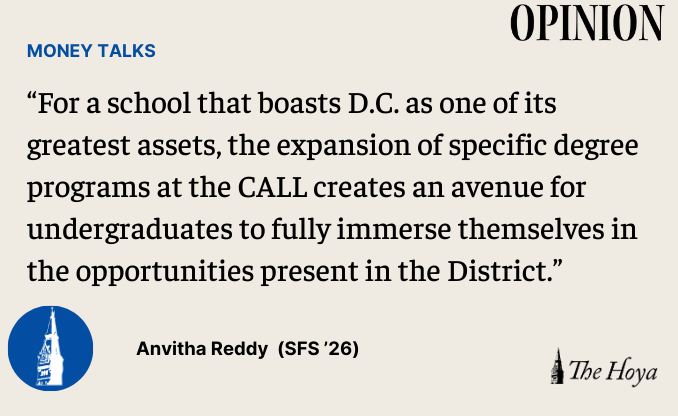Downtown Washington, D.C. is lined with the newest trend in academia: satellite campuses — and Georgetown University seems to be embracing it.
Study abroad has been a part of the college experiences of many students for years, but learning in the District has long been desirable due to the city’s position as the center of U.S. politics. The expansion of various universities’ programming has increased student access to these opportunities.
For example, Santa Clara University’s “Washington Semester” allows students to take on political internships while engaging in a D.C.-based collegiate program. This form of experiential learning is an incredible way for students to immerse themselves in the real-world opportunities that exist after their undergraduate education.
Georgetown, which is less than three miles from Capitol Hill, is at the forefront of these expansions into downtown D.C. The university should continue to invest in its satellite campus by expanding current programs and by adding a more diverse set of classes to increase accessibility to the District’s benefits.
In fall 2019, Georgetown opened its Capitol Applied Learning Labs (CALL) program, which offers undergraduate students an opportunity to spend a semester downtown. Living in the heart of the capital, students select from a wide array of classes, some of which center around immigration in the District and U.S. political campaigns.
The CALL aims to make internship and extracurricular opportunities, such as visiting embassies or working for political consulting groups, more accessible to Georgetown students.
Students living at the CALL are housed in an 11-story residential hall with over 450 beds. This living space is one of the many investments Georgetown has made in its downtown campus network, which includes the purchase of a building near the Law Center for $70 million in 2019.
The decision to acquire more campus space could be pivotal for the future of Georgetown’s academic offerings.
This year, taking notice of the satellite campus trend, Georgetown has widened its undergraduate program downtown.
Students, beginning in this inaugural year, will take two years of classes on the Hilltop and then spend their final two years at Georgetown’s downtown campus, earning an undergraduate degree from the McCourt School of Public Policy. Undergraduate degree programs like this one are distinct from the semester-long programs at the CALL because they offer a wider range of academic programming. For example, Georgetown recently approved an undergraduate degree in environmental science with the Earth Commons, which will begin downtown this spring.
These expansions represent a strategic investment by the university and a great opportunity for Georgetown to take advantage of its unique access to the nation’s capital through state-of-the-art facilities and a preestablished downtown campus.
Although Georgetown’s ambitious efforts to expand further into the District seem alluring, they come with a huge price tag. This project is currently one of the university’s main investment initiatives.
However, the money spent is most definitely justified because it helps to make D.C. opportunities more accessible for students.
Importantly, the downtown expansion would also benefit students living on main campus. They would have the opportunity to take a single experiential learning class or to live downtown for an internship as part of the CALL programming.
Furthermore, with the notoriously poor access to public transportation in the Georgetown neighborhood, the CALL’s location provides a key benefit for downtown accessibility. Living at the Capitol Campus would allow students to better balance career opportunities with their course load, as they would be excused from the logistical constraints of a commute.
For a school that boasts D.C. as one of its greatest assets, the expansion of specific degree programs at the CALL creates an avenue for undergraduates to fully immerse themselves in the opportunities present in the District. Investments in the downtown campus, including spending directed toward the expansion of residential spaces and academic buildings, could further appeal to students, while providing effective marketing for the university.
Anvitha Reddy is a sophomore in the College of Arts & Sciences. This is the second installment of her column, Money Talks.














